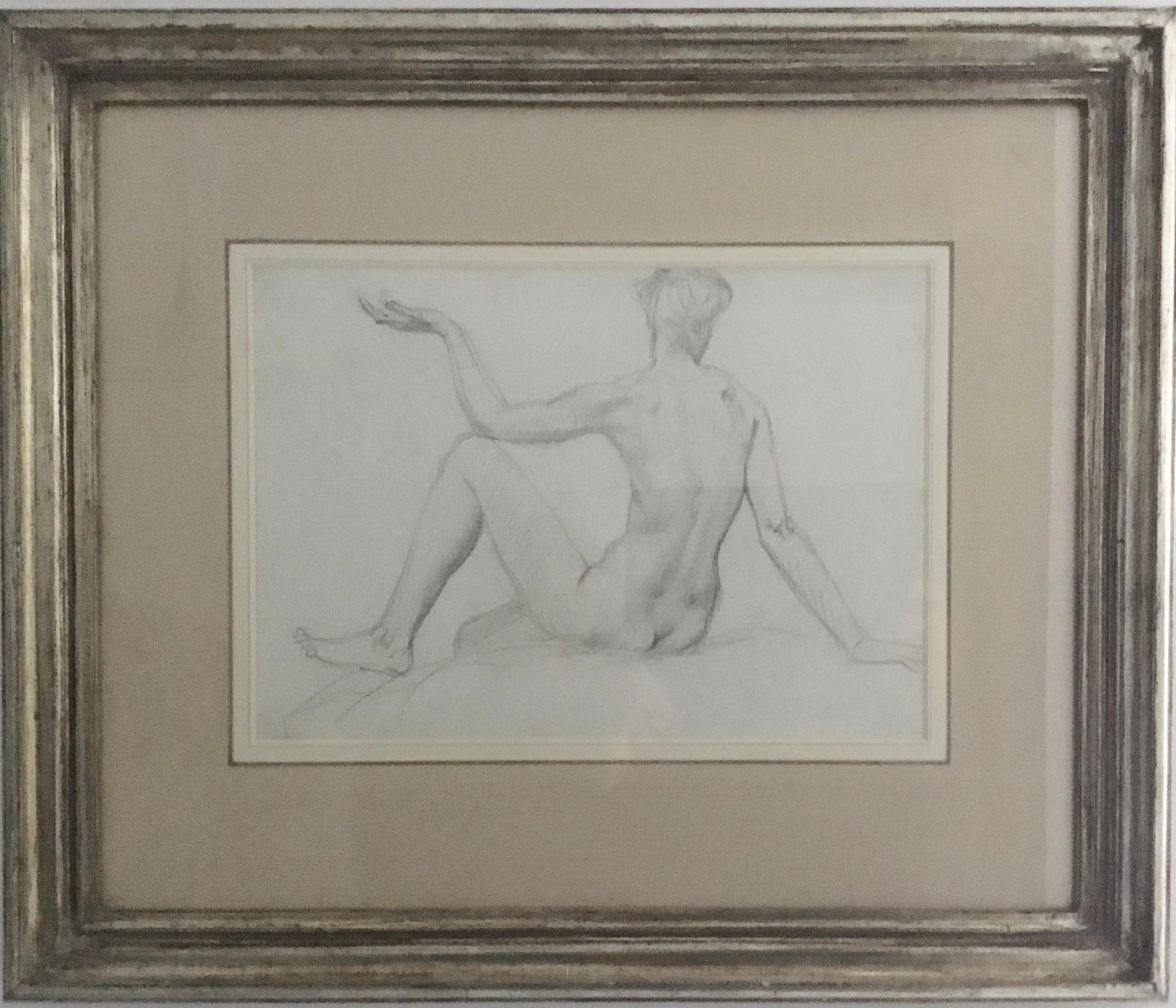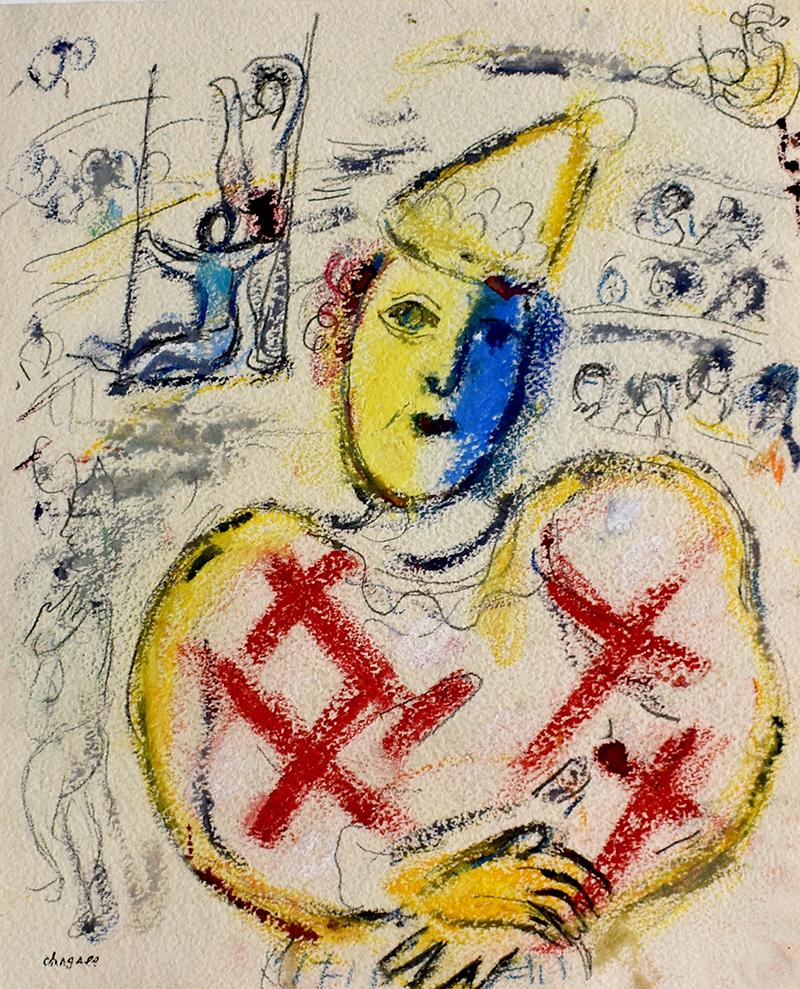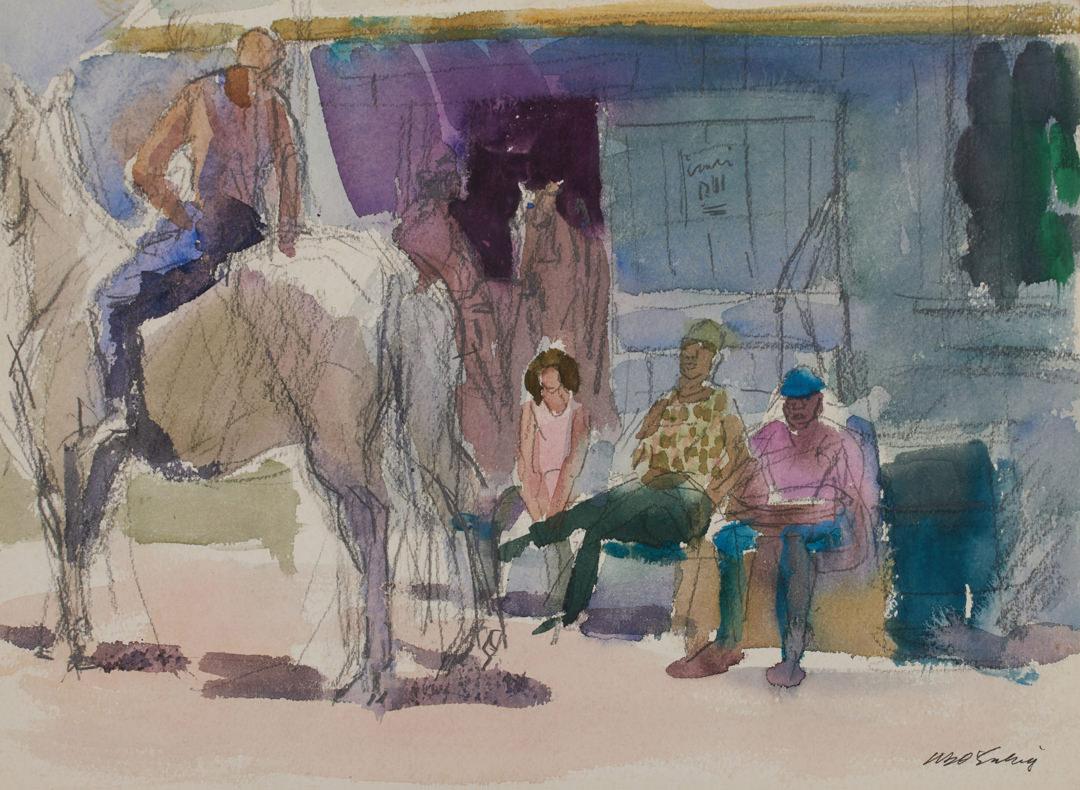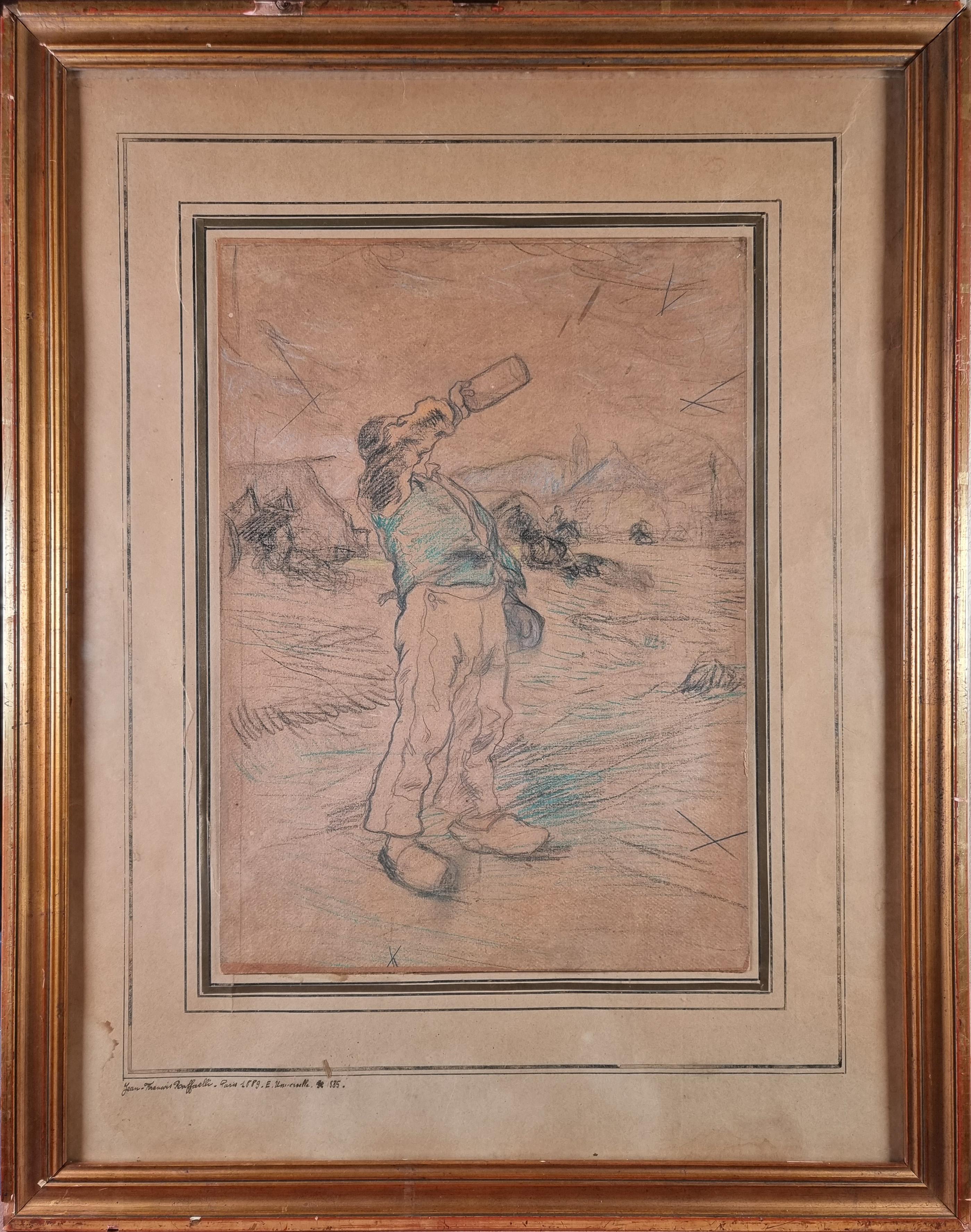Items Similar to Early 20th Century Neo-Impressionist Portrait Drawing on Paper - Figural Studies
Want more images or videos?
Request additional images or videos from the seller
1 of 10
Henri Edmond CrossEarly 20th Century Neo-Impressionist Portrait Drawing on Paper - Figural Studiesc1900
c1900
About the Item
Henri-Edmond Cross
Figural Studies
Graphite and charcoal on paper
18 7/8 x 14 1/4 inches; 47.5 x 35 cm
26.5 x 31 inches; 67.3 x 78.7 cm inc. frame
Henri Edmond Cross (May 20, 1856 - May 16, 1910) was a French pointillist painter.
Cross was born in Douai and grew up in Lille. He studied at the École des Beaux-Arts. His early works, portraits and still lifes, were in the dark colors of realism, but after meeting with Claude Monet in 1883, he painted in the brighter colors of Impressionism.
In 1884, Cross co-founded the Société des Artistes Indépendants with Georges Seurat. He went on to become one of the principal exponents of Neo-Impressionism.
He was a significant influence on Henri Matisse and many other artists. His work was instrumental in the development of Fauvism.
- Creator:Henri Edmond Cross (1856-1910, French)
- Creation Year:c1900
- Dimensions:Height: 18.88 in (47.96 cm)Width: 14.25 in (36.2 cm)
- Medium:
- Movement & Style:
- Period:
- Condition:
- Gallery Location:London, GB
- Reference Number:1stDibs: LU67334481842
About the Seller
5.0
Vetted Seller
These experienced sellers undergo a comprehensive evaluation by our team of in-house experts.
Established in 1990
1stDibs seller since 2017
40 sales on 1stDibs
Typical response time: <1 hour
- ShippingRetrieving quote...Ships From: London, United Kingdom
- Return PolicyA return for this item may be initiated within 1 day of delivery.
More From This SellerView All
- 20th Century Watercolour Painting - At the Fish MarketBy William Lee HankeyLocated in London, GBWilliam LEE-HANKEY (1869-1952, British) At the Fish Market 1904 pencil, watercolor, bodycolor w/gum arabic 20 x 20 inches, inc. frame Provenance: The Swan Gallery...Category
Early 20th Century Romantic Figurative Drawings and Watercolors
MaterialsWatercolor
- Rare Rodin Watercolour & Pencil on Paper of a Seated Nude - The Cambodian DancerBy Auguste RodinLocated in London, GBAuguste RODIN (1840-1917) Seated Nude, Cambodian Dancer c. 1898 - 1900 Pencil and watercolour 11.5 x 9.3 inches; 25 x 20.5 inches, inc. frame Provenance: Christie's South Kensington: Wednesday, November 28, 2007 "It's very simple. My drawings are the key of my art." Rodin was an extraordinary creative artist and a prolific worker. After attending the “Petite École”, he worked in the studio of the ornamentalist Albert-Ernest Carrier-Belleuse, first in Paris, then in Brussels, where his skill in handling decorative subjects fashionable in the 18th century became apparent. His discovery of Michelangelo, during a visit to Italy in 1875-76, was a decisive moment in his career. Rodin would, in turn, break new ground in sculpture, paving the way for 20th-century art, by introducing methods and techniques that were central to his own artistic aesthetics. In 1906, King Sisowath of Cambodia visited France on an official state visit. It was on this visit that Rodin discovered the dancers of the Cambodian Royal Ballet and was inspired to draw and paint them over 150 times. They made a deep impression on the artist, as he confided to Georges Bourdon, in an article for the newspaper Le Figaro on 1 August 1906: “There is an extraordinary beauty, a perfect beauty, about these slow, monotonous dances, which follow the pulsating rhythm of the music… [The Cambodians] have taught me movements I had never come across anywhere before…” Originally seeing them in Paris he left everything suddenly to follow the dancers of the royal ballet to Marseille, from where they would embark on their return to Cambodia. In just one week, he made about one hundred and fifty drawings, re-transcribing or interpreting the ballet poses, with an obvious fascination for the arms and hands of the dancers. These drawings were later highlighted with watercolour, creating coloured harmonies of a rare refinement. The first performance of the Cambodian Royal Ballet took place in the context of the Colonial Exhibition in Marseille. Sisowath 1st had just been crowned King of Cambodia when he undertook the first trip ever to be made by a Cambodian sovereign to France, which had controlled Cambodia since June 1884. This official visit occurred at the height of French colonial expansion. Previously, the Universal Exhibition of 1900 had attracted 48 million visitors! The organisers realised what a tremendous impact this event made on the public, and it was soon adopted as the main tool for colonial propaganda. At the exhibition in Marseilles, the area devoted to Indochina was the largest of the seven sections. When Auguste Rodin met the troupe of dancers for the first time in July 1906, during their brief visit to Paris for an exceptional performance at the Pré Catalan...Category
19th Century Realist Figurative Drawings and Watercolors
MaterialsWatercolor
- Idyllic Landscape Oil Painting of Sheep Grazing with a ShepherdBy André Prevot-ValeriLocated in London, GBAndre Prevot-Valeri Sheep Grazing in a Landscape oil on canvas signed 24 1/4 x 21 1/4 inches, inc. frame André Prévot-Valéri, born in Paris in 1890, died in Granville in 1959, is a ...Category
Early 20th Century Post-Impressionist Animal Paintings
MaterialsOil
- C 20th Portrait of Female Nude by Hollywood favourite Vargas: 'Reclining Nude'By Alberto VargasLocated in London, GBAlberto Vargas was a Peruvian artist best known for his drawings and paintings of pin-up girls that were featured in many notable publications in the 20th century including Esquire a...Category
Late 20th Century Nude Drawings and Watercolors
MaterialsPencil
- Grand 19th Century English Marine Painting in Stunning LightBy John Wilson EwbankLocated in London, GBJohn Wilson Ewbank (1799 - 1847) Shipping in the Harbour, South Shields Oil on canvas 39.5 x 58 inches unframed 47.75 x 66.5 inches framed Provenance: Christie's October 2002; Lot 11. Fine Art Society; Private Collection This marvellous up to scale Ewbank is full of light and warmth and almost certainly his greatest work of the sort rarely - if ever - seen on the market. John W. Ewbank (4 May 1799–28 November 1847), was an English-born landscape and marine painter largely operational from Scotland. The Humber river is a large tidal estuary on the east coast of Northern England. Life Ewbank was born at Darlington on 4 May 1799, the son of Michael Ewbank, an innkeeper. He was adopted as a child by a wealthy uncle who lived at Wycliffe, on the banks of the River Tees, in the North Riding of Yorkshire. Intended for the Roman Catholic priesthood, he was sent to Ushaw College, from which he absconded. In 1813 Ewbank was apprenticed to Thomas Coulson, an ornamental painter in Newcastle. In around 1816 he moved with Coulson to Edinburgh, where he had some lessons with Alexander Nasmyth. He found work both as a painter and a teacher. He was nominated in 1830 one of the foundation members of the Royal Scottish Academy. In 1833 he is listed as living at 7 Union Street on the eastern fringe of the New Town in Edinburgh. Works His sketches from nature were especially admired, and a series of 51 drawings of Edinburgh by him were engraved by W. H. Lizars for James Browne's Picturesque Views of Edinburgh (1825). He also made a reputation with cabinet pictures of banks of rivers, coast scenes, and marine subjects. As an illustrator he illustrated some early editions of Scott's Waverley Novels and one edition of Gilbert White...Category
19th Century Old Masters Figurative Paintings
MaterialsOil
- Beautiful 19th century Oil on Panel Landscape by Richard HilderBy Richard H. HilderLocated in London, GBRichard Hilder (1813-1852) Pastoral Landscape Oil on Panel 10 X 16 inches, Framed Provenance: Important Private Collection Richard H. Hilder was a landscape painter and occasional ...Category
Early 19th Century Landscape Paintings
MaterialsOil
You May Also Like
- Femme à la feuille de vigneBy André DerainLocated in GLEN IRIS, AUAndré Derain Femme à la feuille de vigne pencil, signed with estate stamp lower right, 62 x 37.5 cm Provenance: Atelier Derain; André Charlemagne Derain; the sale of Madame Raymonde Knaublich Saint-Germain-en-Laye, 23 & 24 March 2002: Galerie Schmit...Category
1920s Fauvist Nude Drawings and Watercolors
MaterialsPencil
- STUDY of a SEATED FEMAIL NUDE FROM BEHIND.Augustas Edwin John.OM RA BritishLocated in Pollenca, Illes BalearesBorn in Tenby, Pembrokeshire, John was the younger son and third of four children. His father was Edwin William John, a Welsh solicitor; his mother, Augusta Smith from a long line of Sussex master plumbers,[1] died young when he was six, but not before inculcating a love of drawing in both Augustus and his older sister Gwen.[2] At the age of seventeen he briefly attended the Tenby School of Art, then left Wales for London, studying at the Slade School of Art, University College London. He became the star pupil of drawing teacher Henry Tonks and even before his graduation he was considered the most talented draughtsman of his generation. His sister, Gwen was with him at the Slade and became an important artist in her own right.[4] In 1897, John hit submerged rocks diving into the sea at Tenby, suffering a serious head injury; the lengthy convalescence that followed seems to have stimulated his adventurous spirit and accelerated his artistic growth.[5] In 1898, he won the Slade Prize with Moses and the Brazen Serpent. John afterward studied independently in Paris where he seems to have been influenced by Puvis de Chavannes.His most significant portraits include those of novelist James Joyce, playwright George Bernard Shaw, cellist Guilhermina Suggia, and poets Dylan Thomas and William Butler Yeats. John’s sister, Gwen John...Category
20th Century Post-Impressionist Figurative Drawings and Watercolors
MaterialsPencil
- Study for The Circus - Stamp Signed Gouache, Pastel and Pencil Drawing 1957By Marc ChagallLocated in London, GBMARC CHAGALL 1887-1985 [Shagal, Mark, Zakharovich, Moses] Vitebsk, Belarus 1887-1985 Saint-Paul-de-Vence, Alpes-Maritimes Title: Study for The Circus Equisse pour ‘Le Cirque’, 1957...Category
1850s Fauvist Figurative Drawings and Watercolors
MaterialsPastel, Gouache, Pencil
- Stable Scene, 20th century horse and barn watercolor by Cleveland School artistBy Joseph O'SickeyLocated in Beachwood, OHWork sold to benefit the CLEVELAND INSTITUTE OF ART Joseph B. O’Sickey (American, 1918–2013) Stable Scene Watercolor and graphite on paper Signed lower right 9 x 12.25 inches Josep...Category
Late 20th Century Post-Impressionist Figurative Drawings and Watercolors
MaterialsGraphite, Watercolor
- Post-Impressionist drawing of a man drinkingLocated in Brooklyn, NYThe passepartout contains the following legend 'Jean-François Raffaëlli - Paris 1889 - E. Universelle - 1885'.Category
Late 19th Century Post-Impressionist Figurative Drawings and Watercolors
MaterialsColor Pencil, Paper
- "Young Girl (Jenue Fille)" Louis Valtat, French DrawingBy Louis ValtatLocated in New York, NYLouis Valtat Young Girl Stamped with initials lower right Pencil on brown paper Sight 7 x 6 inches Provenance: Mrs. Ernest M. Werner, New York Private Collection, Rhode Island Loui...Category
Early 20th Century Fauvist Figurative Drawings and Watercolors
MaterialsPaper, Pencil
Recently Viewed
View AllMore Ways To Browse
Early Works
Study On Paper
Century Cross
Antique Crosses
Antique Cross
Cross Antique
Cross X
At Cross Century
Cross Artist
Figurative Study Drawing
19th Century Cross
Antique Study Drawing
Framed Cross
Early 20th Century Impressionist
Drawing Figure Studies
19th Century Impressionist
Antique French Cross
Antique French Crosses




